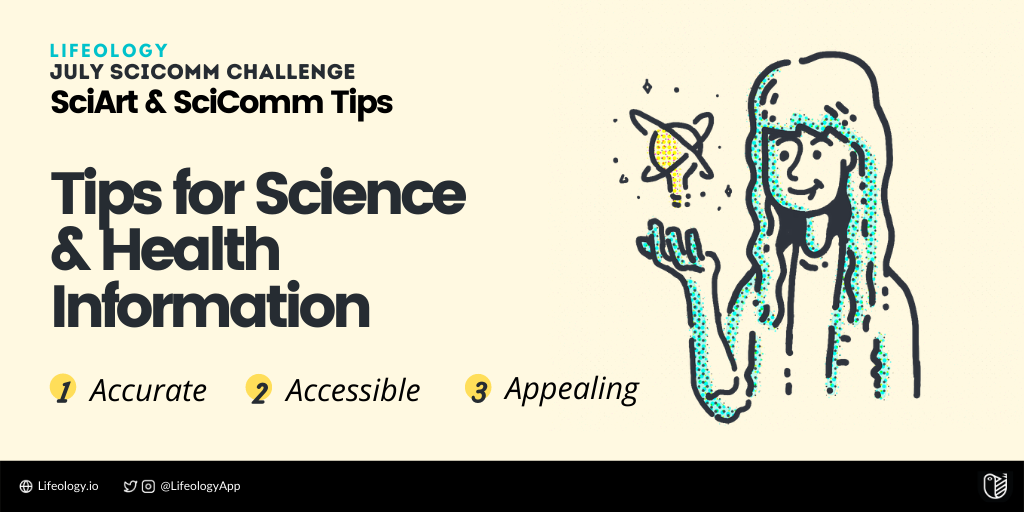For this month’s SciComm challenge, give us your best tips for creating more accessible or engaging science and health communication materials!
What is a strategy you use that others could benefit from? Let us know! This is our simplest challenge to date—all you have to do is share your own knowledge or a resource you’ve learned from!

Historically, health information is not presented in ways that are accessible, which is illustrated by the fact that 9 out of 10 Americans struggle to understand and use health information.
According to the US Health Resources & Services Administration(HRSA), health literacy is “the degree to which individuals have the capacity to obtain, process, and understand basic health information needed to make appropriate health decisions.” There is a correlation between health literacy and health behaviors (e.g., preventive efforts) of individuals.
The HRSA identifies these populations as having the highest prevalence of low health literacy:
- Older adults
- Minority populations
- Those who have low socioeconomic status
- Medically underserved people
How does SciComm and SciArt play a role in all this? It’s not just the responsibility of the individual, but also organizations and other entities communicating about health and science to increase health literacy.
We talk a lot about SciComm, or science communication, here at Lifeology. A definition I like is from Burns et. al 2003: “…the use of appropriate skills, media, activities, and dialogue to produce one or more of the following personal responses to science (the AEIOU vowel analogy): Awareness, Enjoyment, Interest, Opinion-forming, Understanding.” People obtain science and health information online, from friends and family, and from health professionals or other experts. The way that science and health information is communicated is important because it can affect the personal responses one has to science.
One way that SciComm can be improved is through art, so we often talk about SciComm and SciArt in the same breath. How does art help make science accessible? It brings people (that may otherwise not be interested at all) into science and health and engages them by making science seem less scary or far away. By using visuals, comics, poems, and many other forms of art, science can be more accessible (and appealing!) and help improve health literacy rates.
But not all SciArt or SciComm is inherently accurate, accessible, or appealing. How can these be ensured? That’s what this month’s challenge is about! Together, we are going to start a discussion. We’ll start!
A big thing for us at Lifeology is including the audience in the content creation process. We want our content to be accurate, accessible, and appealing. So what better way to ensure we accomplish that goal than to ask our audience? In addition to our experts that ensure accuracy, we also ask for feedback from people from our intended audience and hire artists that are representative of and/or understanding of the audience. Most importantly, we try to include these individuals as early in the process as possible!
What’s a big thing for you in your SciComm or SciArt efforts? Tell us through this month’s challenge! Have you never thought about the way your efforts are related to health literacy? That’s okay! We hope this challenge can serve as a place for our community to identify and share evidence-informed best practices for making science and health information accessible and engaging!
Not quite ready to offer your tips for making information accurate, accessible, and appealing? Be on the lookout for our next SciComm Program course. Spoiler alert! This month’s course is about health literacy! After this course, we bet that you will be ready to participate in this month’s challenge! We can’t wait to hear from our Lifeology community.
July SciComm Challenge
Task:
For this month’s SciComm challenge, give us your best tips for making SciComm and SciArt accurate, accessible, and appealing!
Using our Canva template, write a quick tip for readers. If you are sharing a tip that you learned from a particular credible and reliable source, please share it. See an example below:
Submission:
There is no limit to the number of submissions each person can submit. Email submissions to courtney.adams@lifeomic.com.
All submissions have the opportunity to be included in a roundup blog post.
Further Reading:
- Centers for Disease Control and Prevention – Health Literacy Basics
- Brabers, A, et. al. (2017). What role does health literacy play in patients’ involvement in medical decision-making?
- Lifeology – Visual risk communication: Evidence-based tips for crafting powerful visual messages
- UK Government – Content design: planning, writing and managing content





